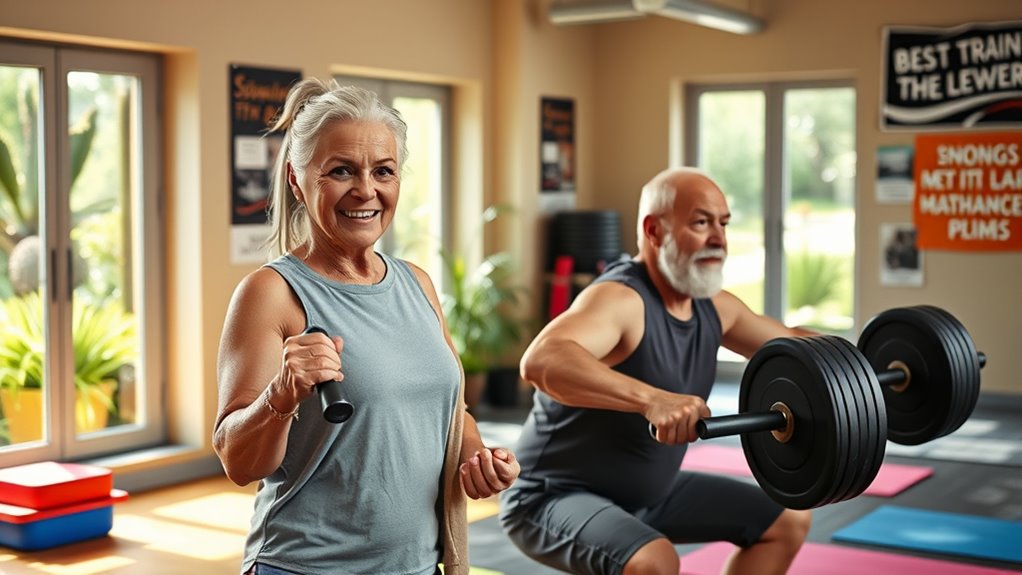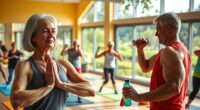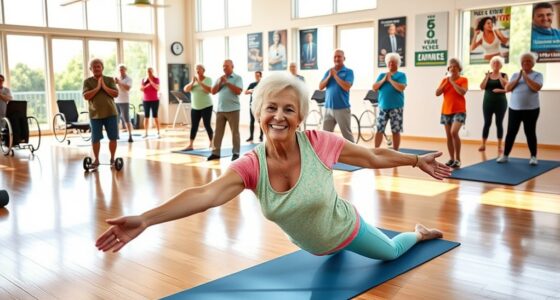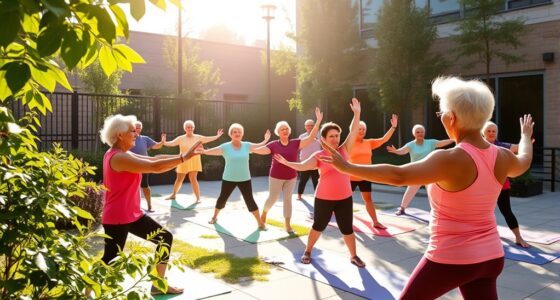Strength training is essential for building and maintaining strength in your golden years. Start with light weights and focus on proper form to avoid injury. Warm up longer to prepare your muscles and cool down afterwards to aid recovery. Nutrition matters too, so aim for sufficient protein intake to support muscle growth. Consistency is key; set achievable goals and stay engaged by joining fitness classes or finding workout partners. There’s plenty more to explore on this journey.
Key Takeaways
- Start with light weights (2-3 pounds) and focus on form to prevent injury as you build strength gradually.
- Incorporate a proper warm-up and cool-down routine to prepare your body and enhance recovery.
- Aim for 1.2 to 2.0 grams of protein per kilogram of body weight to support muscle repair and growth.
- Set SMART goals to track your progress and stay motivated in your strength training journey.
- Engage in community fitness classes for social support, encouragement, and accountability in your routine.
The Importance of Strength Training for Older Adults
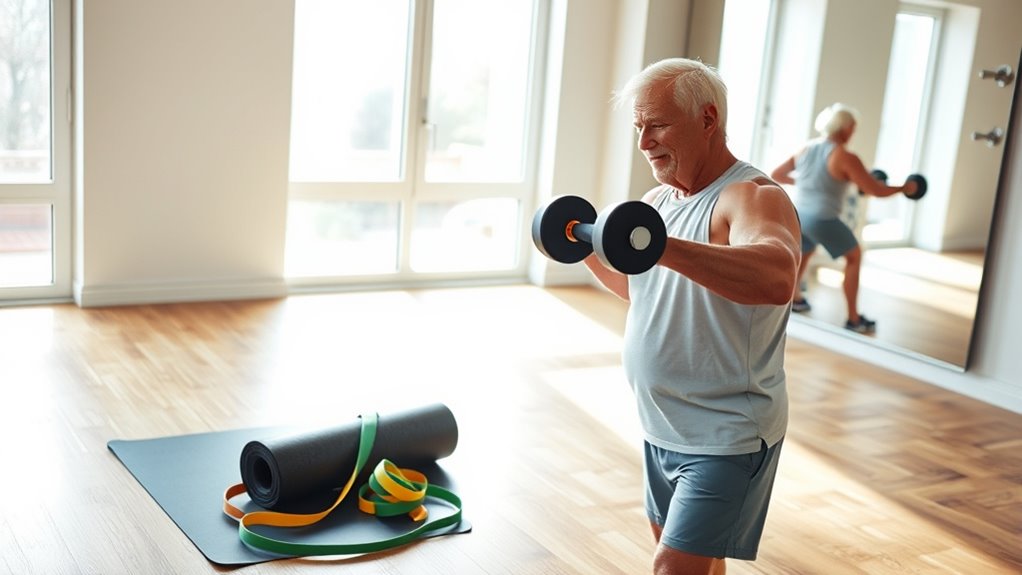
As you age, maintaining your strength becomes increasingly important for your overall health and well-being. Engaging in regular strength training is essential for older adults, as muscle mass declines by 3% to 8% per decade after age 30. This loss accelerates after 60 due to sarcopenia, raising the risk of falls and health issues. Resistance training not only helps preserve muscle mass and strength, but it also improves bone density and balance, reducing the risk of injuries. Regular exercise, including strength training, prevents obesity and related health issues, which is crucial for older adults’ well-being. Additionally, proper nutrition plays a vital role in supporting muscle maintenance and overall health as you age. Incorporating visualization techniques can also enhance your exercise routine, helping to align your mindset with your health goals. Furthermore, home modifications can create a safer environment that encourages regular physical activity.
Moreover, establishing consistent routines in your exercise regimen helps reinforce commitment and stability in your fitness journey. Consistent strength training enhances joint mobility, reduces stiffness, and supports better metabolic and cardiac health. By incorporating strength training into your routine, you can manage chronic conditions like diabetes and arthritis, promoting independence and improving your quality of life.
Starting Strength Training Safely
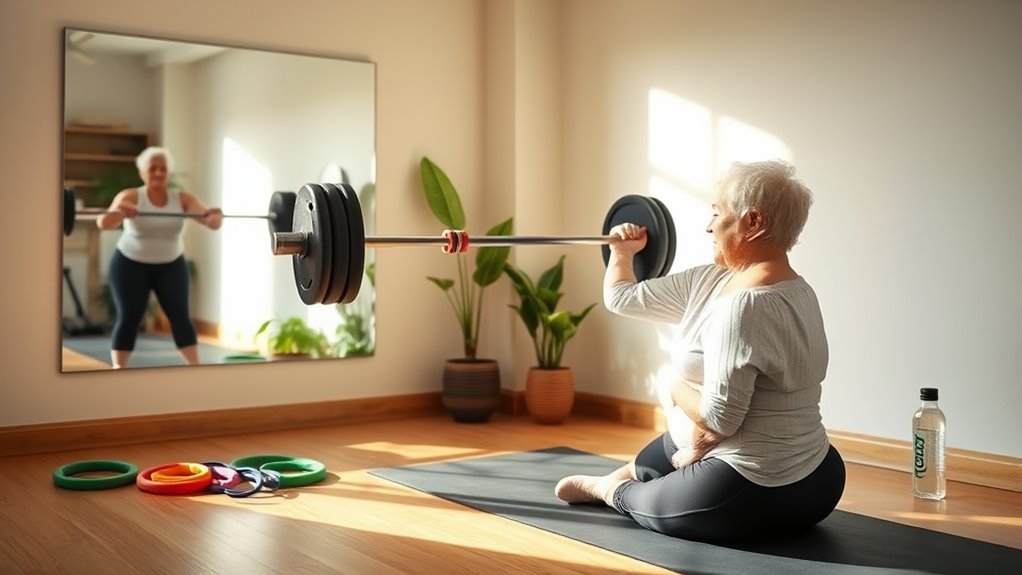
Starting strength training safely is essential for older adults to avoid injuries and guarantee long-term success.
Begin your weight training journey with low weights, around 2-3 pounds, focusing on a few repetitions. This approach builds a solid foundation without risking injury. Engaging in consistent growth through regular exercise can enhance your overall strength and well-being. Additionally, utilizing automation’s role in tracking your progress can provide valuable insights to optimize your training. Including high-protein meals in your diet can also aid in muscle recovery and growth. A nutritious breakfast option like Egg Rollup and Dumpling Sauce can provide the protein needed to kickstart your day.
It’s important to work under the supervision of a knowledgeable personal trainer, who can ensure you maintain proper form and provide real-time feedback.
As your body adapts, gradually increase weights and repetitions while allowing adequate rest between workouts for muscle recovery. Including a balanced breakfast can help sustain energy levels for your workouts.
Always monitor your body’s response to each session and be ready to adjust your regimen based on any discomfort or health changes.
Consulting fitness professionals can help keep your training safe and effective. Additionally, incorporating low-carb meals into your diet can support your strength training efforts and overall health.
Warm-Up and Cool Down Essentials

Before you start lifting weights, warming up is essential to get your muscles ready and reduce injury risk. Engaging in light aerobic activity can also help improve blood flow to the brain, which is particularly beneficial for older adults. Additionally, incorporating essential oils like eucalyptus oil can further enhance your overall wellness and readiness for exercise. Incorporating practices like using air purifiers can also help improve indoor air quality, creating a healthier environment for your workouts. Air quality improvements can significantly reduce allergen exposure, leading to better respiratory health during physical activities.
After your workout, don’t skip the cool down—it helps your body recover and keeps you flexible. Incorporating these practices not only enhances your performance but also supports long-term mobility and health. Additionally, understanding emergency preparedness essentials can help you stay safe while engaging in physical activities.
Importance of Warm-Up
A proper warm-up is essential for everyone, especially seniors, as it prepares your body for the demands of strength training.
Spending 5-10 minutes on light cardiovascular exercises like cycling or brisk walking increases blood flow to your muscles, helping to reduce the risk of injury. Additionally, engaging in consistent maintenance practices can enhance your overall workout effectiveness. Understanding the importance of long-term financial planning for health-related expenses can also motivate you to stay active. Furthermore, proper nutrition plays a crucial role in supporting your energy levels during workouts, allowing for more effective strength training sessions. Incorporating elements of primitive weapons into your routine can also enhance your functional strength and adaptability.
Incorporating dynamic stretches into your warm-up is vital, too, as these movements prepare your joints and enhance flexibility, promoting safe mobility during your workouts. Remember, the aging body requires longer warm-up periods compared to younger individuals, so don’t rush this phase.
Regular warm-ups not only improve your performance but also support long-term joint health, combating issues like joint stiffness and discomfort often experienced in your golden years. Additionally, maintaining good air quality during your workouts can further enhance your overall performance and comfort.
Prioritize this step for a safer, more effective workout.
Effective Cool Down Techniques
While many focus on the intensity of their workouts, effective cool down techniques are just as essential, especially for seniors. A proper cool down aids recovery by gradually lowering your heart rate and improving flexibility, which is vital for injury prevention and can be beneficial in good grief to help manage stress levels. Additionally, adopting self-care practices can further enhance your recovery process and overall well-being. Incorporating humidity levels in your indoor environment can also support respiratory health during physical activities.
Here are four effective techniques to incorporate:
- Walking: Spend 5-10 minutes walking laps around the gym to shift your body back to a resting state.
- Stretching: Target all major muscle groups post-workout to enhance mobility and counteract stiffness.
- Foam Rolling: Use a foam roller to improve tissue health, reduce soreness, and facilitate recovery.
- Deep Breathing: Incorporate deep breathing exercises to relax and promote overall well-being.
In addition, maintaining indoor air quality is crucial for overall health, especially for those engaging in regular physical activity. These techniques will help you maintain consistency in your strength training regimen.
Flexibility and Mobility Benefits
Flexibility and mobility are essential components of any exercise routine, especially for seniors looking to maintain their independence and overall well-being. A proper warm-up, like 5-10 minutes on a stationary bike, boosts blood flow to your muscles, preparing you for activity and reducing injury risk. Engaging in warm-up routines helps counteract stiffness and enhances performance during strength training. Additionally, incorporating gentle stretching before workouts can further enhance your muscle relaxation and readiness. Research indicates that hydration is crucial for optimal muscle function during exercise. Understanding emotional dysregulation can also help seniors manage stress during workouts, contributing to a more positive experience.
Cooling down is equally important; it aids recovery, improves flexibility, and maintains joint health. Stretching during your cool-down phase enhances tissue health and prevents soreness. Here’s a quick look at the benefits:
| Activity | Benefits | Frequency |
|---|---|---|
| Warm-Up | Increases blood flow | Before every workout |
| Cool-Down | Enhances flexibility | After every workout |
| Stretching | Prevents soreness | 3-4 times a week |
| Mobility Exercises | Improves joint function | Daily |
| Flexibility Work | Maintains active lifestyle | 2-3 times a week |
Incorporating mobility exercises into your routine can significantly enhance your overall performance and reduce the risk of injury.
Monitoring Your Health While Training

As you engage in weight training, regular health check-ups are key to staying on track with your overall well-being.
It’s important to listen to your body and adjust your training when you notice any unusual fatigue or discomfort.
Regular Health Check-Ups
Regular health check-ups are essential for seniors engaging in strength training, ensuring your heart and body can handle the increased demands of exercise.
Here are four key reasons to prioritize these check-ups:
- Monitor Cardiovascular Health: Regular assessments help you keep track of your heart’s performance during workouts.
- Track Blood Pressure: Knowing your blood pressure readings can guide you in adjusting exercise intensity safely.
- Identify Preexisting Conditions: Check-ups can reveal any health issues that may affect your training program.
- Receive Personalized Guidance: A fitness professional can help tailor your strength training based on your health status.
Listen to Your Body
Listening to your body during strength training is crucial, especially as we age. You should be mindful of any discomfort or changes in your health during workouts. This awareness helps you make timely modifications to your routine, reducing the risk of injury.
Incorporating regular rest days is important, as aging muscles need longer recovery times to support muscle growth and prevent overexertion. If you have preexisting health conditions, consulting with fitness professionals can help you create a tailored exercise regimen that considers your unique needs.
Staying informed about your personal health status, particularly regarding cardiovascular health, guarantees you engage in strength training safely and effectively. Always prioritize what your body tells you during this journey.
Adjust Training Accordingly
While you’re engaging in strength training, it’s important to adjust your routine based on how your body feels and responds. For older adults, monitoring your health is fundamental.
Here are some tips to adjust training accordingly:
- Regular Check-Ups: Schedule routine health assessments to understand how your body responds to strength exercises.
- Stay Informed: Keep track of any changes in your personal health conditions and be ready to modify your workouts.
- Consult Professionals: Work with fitness experts to design a program tailored to your abilities and health status.
- Monitor Key Signs: Watch your heart rate and blood pressure during workouts, especially if you have cardiovascular concerns.
Listening to your body and allowing for rest is key to maintaining safety and promoting longevity in your fitness journey.
Long-Term Commitment to Strength Training
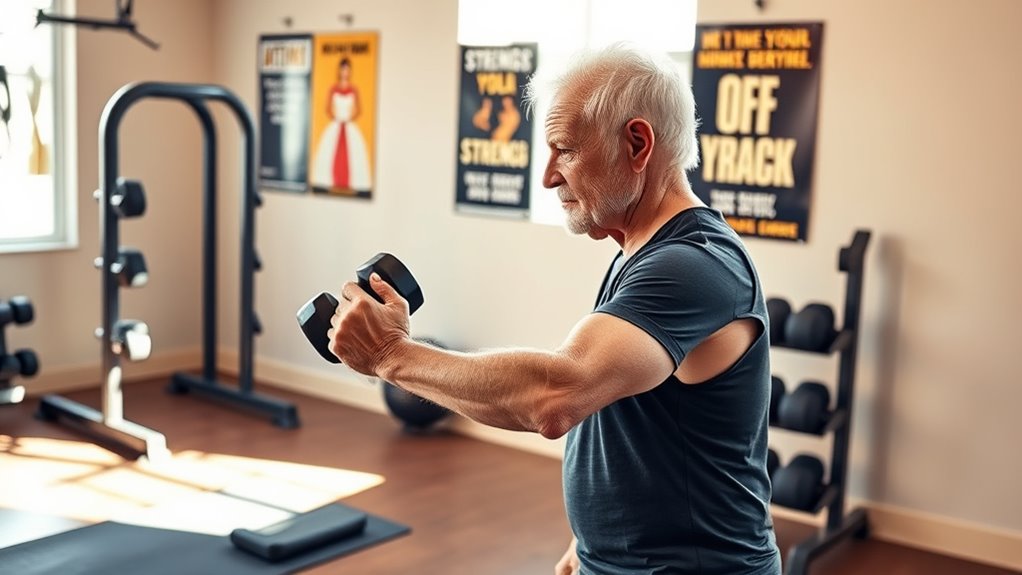
To maintain your strength and overall health as you age, committing to a consistent strength training routine is essential.
For older adults, aiming for two to three training sessions each week guarantees that building muscle strength becomes a lifestyle choice, not a temporary fix. Think of it like taking daily medication for chronic conditions—it’s about long-term commitment.
Gradually increase weights or repetitions to avoid injury, allowing your muscles ample recovery time, especially as you age. Engage in activities you enjoy and consider joining fitness classes or communities to boost your adherence.
Gradually increase weights and allow for recovery to enjoy your strength training journey and minimize injury risk.
Regularly reassess your fitness goals and adjust your routines as your strength improves, helping you stay motivated and committed to your strength training journey for years to come.
Variety in Strength Training Techniques
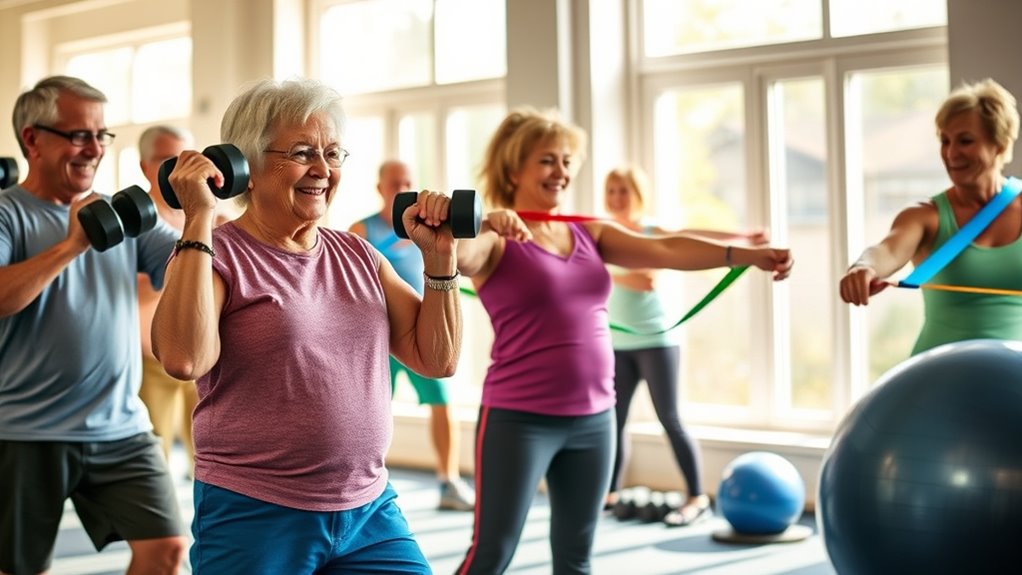
A consistent strength training routine is just the beginning of your journey towards better health as you age.
To effectively build strength and engage your muscles, consider incorporating a variety of techniques:
- Bodyweight Exercises: Use your own weight for resistance to enhance muscle strength without equipment.
- Resistance Bands: These offer versatile resistance while being gentle on your joints.
- Aquatic Training: Water provides resistance while minimizing stress on your joints, making it ideal for older adults.
- Compound Movements: Focus on exercises like squats and deadlifts for thorough muscle engagement.
Pain Management and Recovery Strategies

Effective pain management and recovery strategies are essential for seniors engaging in strength training, as they help prevent injuries and enhance performance.
Start by working out below your pain threshold, gradually increasing weights and repetitions to minimize discomfort. Listen to your body and allow adequate rest periods, especially since aging muscles regenerate more slowly and need more time to recover.
Incorporate recovery strategies like stretching and foam rolling to improve tissue health and prevent muscle loss. Staying active even with low-level preexisting pain is vital, but make adjustments to avoid exacerbating discomfort.
Finally, don’t forget post-workout hydration and stretching to greatly boost muscle recovery and overall performance. Prioritizing these practices will keep you strong and injury-free.
Focus on Nutrition for Muscle Building

Nutrition plays a critical role in muscle building, especially for seniors looking to maintain strength and energy. To optimize your nutrition, focus on these key elements:
Nutrition is vital for seniors to build muscle and sustain energy; prioritize protein and nutrient-dense foods for optimal results.
- Increase protein intake: Aim for 1.2 to 2.0 grams of protein per kilogram of body weight daily to support muscle repair and growth.
- Choose nutrient-dense foods: Incorporate lean meats, fish, eggs, legumes, and dairy to meet your protein needs and fuel your body.
- Stay hydrated: Drink water consistently throughout the day, especially before and after workouts, to enhance muscle function and recovery.
- Time your meals: Have a protein-rich snack or meal post-exercise to maximize muscle repair and growth after strength training sessions.
Staying Motivated and Engaged in Your Fitness Journey

Building muscle through proper nutrition is only part of the journey; staying motivated is key to making lasting changes in your fitness routine.
Set SMART goals to track your progress, giving you clear benchmarks to aim for. Choose activities you enjoy, like yoga or group classes, to stay engaged and reduce intimidation.
Involving a friend or family member can greatly boost your motivation and accountability, making workouts more fun. Celebrate small victories, whether it’s lifting heavier weights or gaining endurance; this reinforces the importance of consistency over perfection.
Finally, connect with a supportive community, whether through local classes or online forums, as shared experiences can enhance your motivation to maintain an active lifestyle.
Frequently Asked Questions
What Is the 6 12 25 Rule?
The 6-12-25 rule is a versatile training strategy that you can incorporate into your workouts.
It involves performing six reps with heavy weights, twelve with moderate weights, and twenty-five with lighter weights. This approach helps you target different muscle fibers, enhancing muscle hypertrophy and overall strength.
What Is the No. 1 Exercise for Aging?
The number one exercise for aging is the squat. It targets multiple muscle groups, improving your lower body strength and balance, which are essential for preventing falls.
You can easily modify squats to fit your fitness level, starting with bodyweight and adding weights or bands as you progress.
Regularly performing squats enhances mobility, making daily tasks easier, and helps maintain your independence by supporting overall functionality in your life.
How Do You Strengthen Weak Muscles in Old Age?
To strengthen weak muscles in old age, you should engage in strength training at least 2-3 times a week.
Focus on lighter weights and perform 8-12 repetitions to master your technique. Incorporate exercises targeting large muscle groups, like leg presses and chest presses.
Use resistance bands or body-weight exercises for a low-impact approach.
Prioritize proper form and listen to your body’s signals, adjusting your training as needed to avoid injury and promote recovery.
How Do You Progressively Build Strength When Lifting Weights?
Building strength when lifting weights is like sculpting a masterpiece; it takes time and patience.
Start with lighter weights to master your form, then gradually increase resistance by 5-10% every few weeks. Aim for 8-12 reps initially, shifting to 3-6 with heavier weights as you progress.
Keep your muscles guessing by varying workouts and allow at least 48 hours for recovery. This approach guarantees you effectively challenge your body and stimulate growth!
Conclusion
As you embrace strength training in your golden years, remember this: it’s never too late to build muscle and boost your overall health. Studies show that even modest resistance training can greatly improve your strength, balance, and mood. So, don’t let age hold you back; commit to a routine, enjoy the process, and watch your body transform. With the right mindset and techniques, you’ll not only feel younger but also thrive in every aspect of your life.
